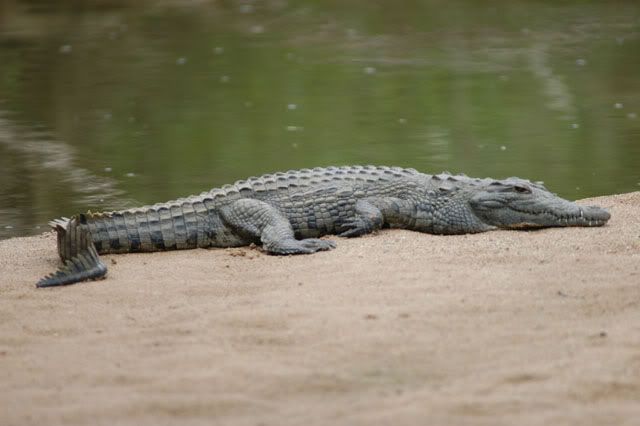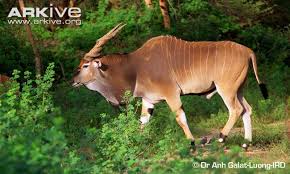Post by dinosauria101 on Mar 2, 2019 4:15:43 GMT 5
Nile Crocodile - Crocodylus niloticus
The Nile crocodile or Common crocodile (Crocodylus niloticus) is an African crocodile which is common in Somalia, Ethiopia, Uganda, Kenya, Egypt, Tanzania, Zambia, Zimbabwe, Gabon, South Africa, Malawi, Sudan, Botswana, and Cameroon. Isolated populations also exist in Madagascar, Senegal. Nile crocodiles have a dark bronze colouration above, with black spots on the back and a dirty purple on the belly. The flanks, which are yellowish green in colour, have dark patches arranged in oblique stripes. The Nile crocodile is the largest crocodilian in Africa and is sometimes regarded as the second largest crocodilian after the saltwater crocodile. The male crocodile usually measure from 11.5 to 16 feet long (3.5 to 5 metres), but very old, mature ones can grow to 18 ft (5.5 m) or more. Like all crocodiles they are sexually dimorphic, with the males up to 30% larger than the females, though the difference is even more in some species, like the saltwater crocodile. Mature female Nile crocodiles measure 8 to 13 ft (2.4 to 4.0 m) Typical Nile crocodile weight is from 150 to 750 kg (330 to 1,540 lb), averaging 527 kg in Limpopo, South Africa. The largest accurately measured male was shot near Mwanza, Tanzania and measured 6.45 m (21.2 ft) and weighed approximately 1,090 kg (2,400 lb).

Giant Eland - Taurotragus derbianus
The giant eland (Taurotragus derbianus), also known as the Lord Derby eland, is an open-forest savanna antelope. A species of the family Bovidae and genus Taurotragus, it was first described in 1847 by John Edward Gray. The giant eland is the largest species of antelope, with a body length ranging from 220–290 cm (87–110 in). There are two subspecies: T. d. derbianus and T. d. gigas. As a herbivore, the giant eland eats grasses, foliage and branches. Giant elands usually form small herds consisting of 15–25 members, both males and females. They are not territorial, and have large home ranges. They are naturally alert and wary which makes them difficult to approach and observe. They can run at up to 70 km/h (43 mph) and use this speed as a defense against predators. Mating occurs throughout the year but peaks in the wet season. They mostly inhabit broad-leafed savannas, woodlands and glades. The giant elands are spiral-horned antelopes. Despite its common name, this species broadly overlaps in size with the common eland (Taurotragus oryx). However, the giant eland is the slightly larger species on average and is the largest species of antelope in the world. Giant elands are typically between 220 and 290 cm (7.2 and 9.5 ft) in head-and-body length and stand approximately 130 to 180 cm (4.3 to 5.9 ft) at the shoulder. Giant elands exhibit sexual dimorphism, as males are larger than females. The males weigh 400 to 1,000 kg (880 to 2,200 lb) and females weigh 300 to 600 kg (660 to 1,300 lb).

Credit to Wikipedia
The Nile crocodile or Common crocodile (Crocodylus niloticus) is an African crocodile which is common in Somalia, Ethiopia, Uganda, Kenya, Egypt, Tanzania, Zambia, Zimbabwe, Gabon, South Africa, Malawi, Sudan, Botswana, and Cameroon. Isolated populations also exist in Madagascar, Senegal. Nile crocodiles have a dark bronze colouration above, with black spots on the back and a dirty purple on the belly. The flanks, which are yellowish green in colour, have dark patches arranged in oblique stripes. The Nile crocodile is the largest crocodilian in Africa and is sometimes regarded as the second largest crocodilian after the saltwater crocodile. The male crocodile usually measure from 11.5 to 16 feet long (3.5 to 5 metres), but very old, mature ones can grow to 18 ft (5.5 m) or more. Like all crocodiles they are sexually dimorphic, with the males up to 30% larger than the females, though the difference is even more in some species, like the saltwater crocodile. Mature female Nile crocodiles measure 8 to 13 ft (2.4 to 4.0 m) Typical Nile crocodile weight is from 150 to 750 kg (330 to 1,540 lb), averaging 527 kg in Limpopo, South Africa. The largest accurately measured male was shot near Mwanza, Tanzania and measured 6.45 m (21.2 ft) and weighed approximately 1,090 kg (2,400 lb).

Giant Eland - Taurotragus derbianus
The giant eland (Taurotragus derbianus), also known as the Lord Derby eland, is an open-forest savanna antelope. A species of the family Bovidae and genus Taurotragus, it was first described in 1847 by John Edward Gray. The giant eland is the largest species of antelope, with a body length ranging from 220–290 cm (87–110 in). There are two subspecies: T. d. derbianus and T. d. gigas. As a herbivore, the giant eland eats grasses, foliage and branches. Giant elands usually form small herds consisting of 15–25 members, both males and females. They are not territorial, and have large home ranges. They are naturally alert and wary which makes them difficult to approach and observe. They can run at up to 70 km/h (43 mph) and use this speed as a defense against predators. Mating occurs throughout the year but peaks in the wet season. They mostly inhabit broad-leafed savannas, woodlands and glades. The giant elands are spiral-horned antelopes. Despite its common name, this species broadly overlaps in size with the common eland (Taurotragus oryx). However, the giant eland is the slightly larger species on average and is the largest species of antelope in the world. Giant elands are typically between 220 and 290 cm (7.2 and 9.5 ft) in head-and-body length and stand approximately 130 to 180 cm (4.3 to 5.9 ft) at the shoulder. Giant elands exhibit sexual dimorphism, as males are larger than females. The males weigh 400 to 1,000 kg (880 to 2,200 lb) and females weigh 300 to 600 kg (660 to 1,300 lb).
Credit to Wikipedia




